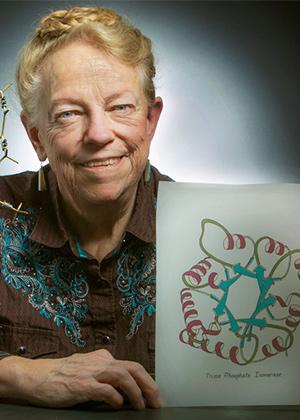
In almost every scientific paper that describes proteins you’ll find Duke biochemist Jane Richardson’s handiwork. The images, commonly referred to as “ribbon diagrams,” are basic to the language of protein science. Ranging in likeness from a flapping kite tail to a tight coil of crimped gift ribbon, these carefully etched diagrams invented by Richardson have served for many years as a primary way that scientists can describe what they see in their data.
Often called the ‘building blocks of life,’ proteins are themselves a sort of language. Found in every living organism, their 3D shapes determine the function and structure of body tissues such as muscle or skin and chemical functions such as breathing, digestion or growth. Understanding their precise structure and interactions is important for drug design to improve human health. Some of the most widely-used drugs, including the antibiotic penicillin, have been redesigned and improved due to better understanding of the proteins they target.
Read about Jane Richardson and how she designed the original Ribbon Diagram at Duke Stories